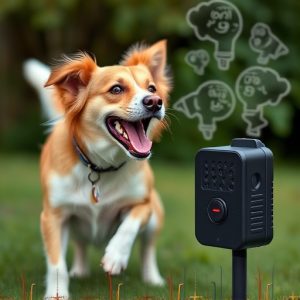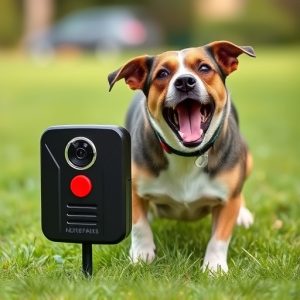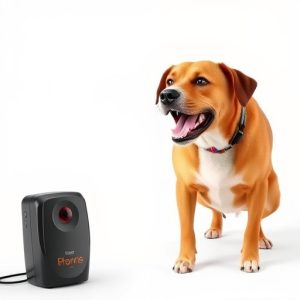Handheld Sonic Dog Deterrents: Real-World Effectiveness & Ethical Use
Handheld sonic dog deterrents, popular for managing canine behavior in residential areas, emit high-…….
Handheld sonic dog deterrents, popular for managing canine behavior in residential areas, emit high-frequency sounds (20-50 kHz) that are unpleasant to dogs but harmless to humans. They quickly modify dog behavior without lasting harm, making them a preferred choice for pet owners and authorities. Effectiveness varies based on breed, temperament, training, environmental noise, and consistent usage. Responsible use involves adhering to local regulations, user training, respecting property boundaries, considering alternatives, and clear community communication to maximize benefits while minimizing potential harm.
Neighborhood dog control has evolved with the introduction of sonic equipment, particularly handheld devices designed to deter unwanted canine behavior. This article delves into the world of handheld sonic dog deterrents, exploring their functionality, advantages, and potential drawbacks. We examine real-world effectiveness and delve into ethical considerations surrounding their responsible use. Understanding how these devices work is crucial in navigating their application for a peaceful coexistence between residents and their four-legged neighbors.
- Understanding Sonic Dog Deterrents: How Do They Work?
- Handheld Devices: Advantages and Disadvantages
- Effectiveness in Real-World Scenarios
- Ethical Considerations and Responsible Use
Understanding Sonic Dog Deterrents: How Do They Work?
Sonic dog deterrents have gained popularity as a non-lethal method to control and manage canine behavior, especially in residential neighborhoods. These devices emit high-frequency sound waves that are designed to be unpleasant for dogs, encouraging them to avoid certain areas. The technology behind these deterrents is based on the idea of creating an auditory barrier that disrupts a dog’s ability to remain calm and focused in a specific location.
When activated, handheld sonic dog deterrents emit sounds within the 20-50 kHz range, which is beyond the human hearing spectrum but can be perceived as annoying or even painful for dogs. This high-frequency sound doesn’t harm the animal physically; instead, it triggers an instinctive response to avoid the source. The effectiveness of these devices lies in their ability to quickly change a dog’s behavior without causing lasting harm or fear. As a result, they have become a preferred choice for pet owners and local authorities seeking humane solutions to manage dog-related issues in public spaces.
Handheld Devices: Advantages and Disadvantages
Handheld sonic dog deterrents have gained popularity as a non-lethal method to control canine behavior in neighborhoods. These devices offer several advantages, particularly for pet owners and communities seeking peaceful co-existence with their four-legged neighbors. The primary benefit lies in their portability; handheld devices allow users to quickly address barking issues without relying on constant professional intervention. They are easy to use, often requiring simply pointing the device towards the dog to emit a high-frequency sound that is unpleasant to canines but harmless to humans. This immediate response can be especially effective for sudden or sporadic barking incidents.
However, there are also disadvantages to consider regarding handheld sonic deterrents. While they may be effective in certain situations, their success depends heavily on the dog’s breed, temperament, and training. Some dogs might not react at all, while others could become desensitized over time. Additionally, the effectiveness of these devices can be limited by environmental factors; background noise or weather conditions might interfere with the sound projection, reducing their overall impact. Moreover, like any tool relying on user operation, consistency in usage is crucial for success, and improper use could lead to counterproductive results.
Effectiveness in Real-World Scenarios
In real-world scenarios, handheld sonic dog deterrents have proven to be an effective tool in managing canine behavior. These devices emit high-frequency sound waves that are unpleasant for dogs, encouraging them to leave the area or stop unwanted behaviors like barking and roaming. Studies show that the immediate impact of these deterrents can last up to several minutes, giving pet owners and neighbors a temporary respite from dog-related disturbances.
The effectiveness of handheld sonic deterrents lies in their convenience and ease of use. They are portable, allowing users to quickly address issues as they arise. Moreover, the non-lethal nature of these devices makes them a humane alternative to traditional, more aggressive training methods. This approach not only addresses immediate concerns but also fosters a positive environment where dogs and humans can coexist peacefully in shared spaces.
Ethical Considerations and Responsible Use
The handheld sonic dog deterrent devices have gained attention as a potential solution for managing canine behavior, particularly in public spaces. However, it’s crucial to approach their use with ethical considerations and responsible practices. The primary concern revolves around the well-being and impact on animals, as these devices emit high-frequency sound waves aimed at disturbing dogs’ attention and encouraging them to leave the area. While studies suggest a notable deterrent effect, there are potential drawbacks. Not all dogs may react similarly; some breeds or individuals might be more sensitive to such sounds, leading to unnecessary stress or even hearing damage if not used correctly.
Responsible use involves adhering to local regulations and ensuring user training. It’s essential for dog owners or control officers to employ these tools only when necessary, respecting the boundaries of private properties, and considering alternative methods first. Regular monitoring and proper application techniques are vital to maximize effectiveness while minimizing harm to animals. Additionally, clear communication with the community about the use of sonic deterrents can foster understanding and cooperation in maintaining a peaceful urban environment for both residents and their four-legged companions.
Neighborhood dog control through handheld sonic equipment offers a non-lethal, humane approach to managing canine behavior. While these devices have shown promise in terms of effectiveness, it’s crucial to weigh their advantages and disadvantages, such as range limitations and potential environmental impact. Ethical considerations demand responsible use, ensuring the well-being of both dogs and the community. Continuous research and user feedback are vital to optimizing handheld sonic dog deterrents for real-world applications. Ultimately, a balanced approach combining training, fencing, and targeted technology can create peaceful co-existence between pets and their neighbors.


